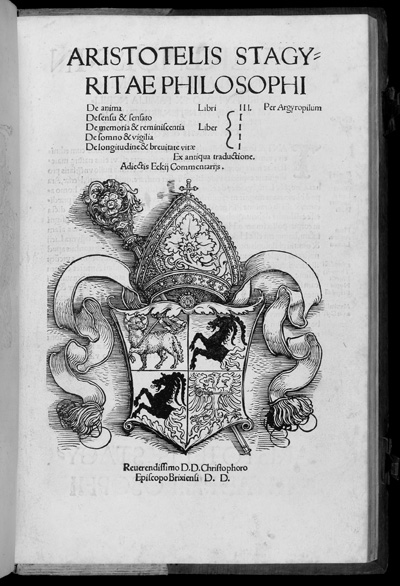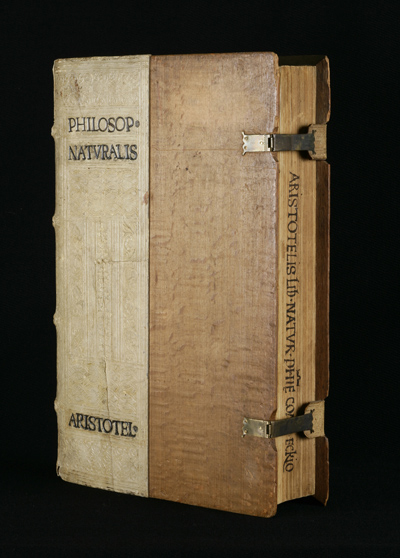|
|
|
|
|
|
|
|
|
|
|
ARISTOTLE
|
|
Physicae Libri. VIII
|
|
Augsburg: Grimm & Wirsung, 1518
|
|
[bound with]
|
|
Libri De Coelo. III
|
|
Augsburg: Grimm & Wirsung, 1519
|
|
[bound with]
|
|
De Anima. Libri III
|
|
Augsburg: Grimm & Wirsung, 1520
|
|
Folio
|
|
Contemporary blindstamped half pigskin over wooden boards, clasps and catches.
|
|
|
|
|
|
|
|
|
|
|
|
|
|
|
|
|
|
|
|
The book as edifice
|
|
This volume of Aristotle's chief scientific works is both a physical and textual monument to the place that classical humanistic learning held in early modern Europe. The invention of printing made possible the dissemination of written texts to a much wider audience while at the same time the economic, social, and intellectual climate of the time combined to create an elite class of highly educated readers for whom the printed book was a veritable citadel of learning. Books of that time were very expensive (this volume probably cost its owner about $1000 in present-day money); knowledge of Greek and Latin was still mainly confined to the upper classes, as was an appreciation of the classical authors; and the esteem in which those authors was held was so high that their books were considered literally to be the sole source of all significant learning. It is therefore unsurprising that scholarly and humanistic books of the period were stately, imposing tomes, beautifully printed and built to last. All of that changed with the reformation, which brought to a close the period of elitist scholarship and began a new period of book publishing at the populist level.
|
|
|
|
The book as artifact
|
|
|
|
The binding of half pigskin over wooden boards is a well preserved example of a German bookbinding from the first period of printed books. Each element is instructive. Given the abundance of porcine livestock in Germany, pigskin was readily available and an obvious choice for bookbindings. It is exceptionally strong and durable, which accounts for this example's state of preservation. However, it has the drawback that it will not take gold stamping. Thus the only ornamentation that one finds on pigskin bindings is in the form of blindstamping (patterns impressed into the skin) and occasional ink markings.
|
|
|
|
The wooden boards and clasps are part of a binding tradition from much earlier times, when manuscript books were generally written on vellum or parchment rather than paper. Vellum is extremely sensitive to moisture and has the habit of "cockling" (wrinkling and curling) as the humidity fluctuates. (It makes an excellent hygrometer.) The boards and clasps served to keep the leaves pressed flat; otherwise the book would soon look like a sprung-open accordion. Even after the switch to paper, which generally lies flat all on its own, this binding style persisted, particularly in Germany. It is, in fact, quite functional in keeping the book closed and well protected.
|
|
|
|
The placement of the written title is also significant. Until the mid-sixteenth century, books were shelved either flat on their backs or with the fore-edge facing out (that's why it's called the fore-edge). Hence the book title would be written on the fore-edge or the front cover (if it appeared anywhere at all). On this example, the identification appears in both places.
|
|
|
|
Finally, the volume is a "sammelband" (i.e., a group of texts bound together). This was an obvious economy measure, because bindings were expensive. Generally, but not always, a sammelband comprised related works, but in an example such as the Apianus' Instrument Buch shown elsewhere on this site, the work on measuring instruments is bound together with a geometrical treatise and an early work on horsemanship in an unlabeled pigskin binding. One might ask how one could find a book that one wanted in a library of sammelbands of unrelated works in unmarked bindings, but in the sixteenth century a scholar likely owned no more than a few dozen bound volumes, and would have known exactly what was in each one.
|
|
|

|
|
|
|
|
title page from Aristotle, De Anima, Augsburg 1520.
|
| |
| |
| |
| |
|

| |
| |
| |
Aristotle Sammelband, Augsburg 1518 - 1520.
|
|

